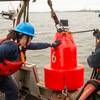America’s First Marine Highway Comes Back to Life
The New York State Canal System, once forgotten as a commercial shipping option, is on the rise again, after years of decline. The shorter, greener and smarter route(s) make increasingly good sense for high value cargoes.
Commercial utilization of America’s original superhighway – the Erie Canal – is on the rise again in recent years after years of decline. The third generation of the famed Erie Canal – the “Barge Canal” was constructed between 1905 and 1918. Designed to accommodate up to 10 million tons of cargo per year, the modern Erie Canal peaked at just over 5 million tons in 1951. Then, and with growing competition from railroads and highways, and the opening of the St. Lawrence Seaway in 1959, commercial traffic on the Canal System declined dramatically in the latter part of the 20th century.
Over the last two decades, commerce has slowed to a trickle along the Canal System, which has become a major recreational boating destination. Cargo volume on the Canal in recent years would average 10,000 tons annually or less, and in 2011, only 6,150 tons were recorded. In 2012, tonnage exceeded 43,000 tons and in 2013 – a year plagued by flooding and extensive repairs on the Canal – 96,433 tons of cargo was shipped on the Canal, the highest total since 1993.
The New York State Canal System is a 524-mile long, commercially viable waterway connecting the Hudson River with the Great Lakes, Finger Lakes, and Lake Champlain. The federally improved route between Waterford and Oswego provides a vertical clearance of at least 21 feet; the Champlain Canal has at least 17 feet; Cayuga-Seneca Canal, 16; and the western Erie Canal, 15.5. The controlling depth on the Erie Canal between Waterford and Oswego is currently 11 feet; the Champlain Canal is 9.5 feet; Cayuga-Seneca Canal, 8; and the western Erie Canal, 9. Efforts are underway to return the Canal System to its published depth of 14 feet from Waterford to Oswego and 12 feet elsewhere.
Today, the Canal System remains a viable artery for the movement of bulk and project cargo. With connections to the Great Lakes and the St. Lawrence Seaway, as well as to the interior of New York State where manufacturing and commerce is on the rise, today’s Canal System can be an effective complement to land-based transportation systems – completing the intermodal chain – around and within the Empire State.
The locks of the New York State Canal System have a usable length of 296 feet and a usable width of 44.45 feet. The Canal Corporation recommends a beam of no greater than 43.5 feet. Every lock on the New York State Canal System is equipped with a capstan for the purposes of double locking. Several Canal terminals remain available for commercial use, but with little or no infrastructure for loading and unloading cargo. A variety of aids to navigation mark the channels of the New York Canal System, with the vast majority of these aids being unlighted. Products still shipped on the Canal System include pre-fabricated rebar caissons, liquid calcium chloride, radar dome material, commercial paper dryers, aggregate, turbines, commercial boilers, transformers, and other over-sized cargo.
On the Water
It might surprise you to know that at least five barge towing companies ply the NYS Canal System. NYS Marine Highways is one of those firms. NYS Marine Highways’ Rob Goldman told MarineNews in March that his firm accounts for as much as 85 percent of all cargo moved on the canal last year. He said, “The canal is ideal for high value, project and heavylift cargoes.” In other words: the perfect cargoes for shortsea shipping. Other cargoes include the movement of Canadian corn to ethanol plants using hopper barges.
According to Goldman, last year’s problems and two months of lost time on the water probably cost the waterway another 50,000 tons that could have been moved. Beyond this, he says, the system is handicapped because it is not being currently maintained to its project depth – something many inland waterways operators, no matter where they push their barges, can relate to.
Air draft and water depth can also be an issue, he said. His 1,800 and 1,400 HP towboats therefore have retractable wheelhouses to accommodate the sometimes difficult conditions. Goldman’s biggest year on the New York Canal System coincided with the year that Enron failed. As it turned out, numerous, high value turbines had to be moved into storage. The shippers turned to Goldman and his fledgling operation. The rest is history.
Goldman says, “Canal service providers are problem solvers. The tugs, in this case, are tools. Shippers have unique requirements and we meet those needs with innovative solutions.”
Unlimited Possibilities: Shorter & Greener
For those not convinced of the canal(s) utility, shippers moving cargo from mid-Atlantic ports to the Great Lakes should take notice. The benefits in terms of fuel savings alone can be enormous. Consider that Philadelphia to Oswego (NY) is 1,884 miles outside; via canal, just 536 miles. Shorter, greener – the canal beckons. Could a company get carbon credits for doing the right thing inland? Rob Goldman further insists that if water depths increase through better dredging and maintenance, the economy of scale for lesser value cargoes also increases. John F. Kennedy perhaps said it best – although not referring to the New York State Canals – that, “When the tide comes in, all boats float.”
We asked both Goldman and New York Canal officials about the possibility of the canal being used in the near term to move crude oil from the Midwest fracking production fields. Currently, much of that moves East via train – but that’s becoming increasingly unpopular, especially given several high profile derailments and questions about the safety of moving volatile crude oils via railroad. But, according to Goldman, the state of New York requires a twin screw arrangement for any vessel pushing petroleum cargoes, something that’s not practical in the canals. “Operators would need an exclusion,” he said. As for the New York State Canal System, the issue of fracking oil is a sensitive one. Local officials want to increase commerce, but not necessarily the drama or politics that accompany something that is, to date, a controversial issue. Arguably, there is no more direct, greener, shorter or more sensible route to do so.
Shortsea Shipping: Models, Modes and Maximizing Logistics
A Commercial Shipping Study completed for the Canal Authority in May 2010 (www.canals.ny.gov/business/modern-freightway.pdf) clearly demonstrated the benefits of waterborne freight logistics and makes the case for instituting container-on-barge service on the New York State Canal System. Summarizing numerous studies comparing the energy requirements and environmental externalities of freight transportation modes, the report provides a roadmap through some of the best prior research that demonstrates the benefits of waterborne logistics.
The report went on to say, “Since barge traffic on the New York State Canal System declined five decades ago, much has changed in modern logistics. Containerized cargo revolutionized global trade, enabling multi-modal systems that move cargo farther, faster and cheaper but regions that fail to embrace “the box” run the risk of being left behind.” Significantly, the report points to the European shortsea model, with the Rhine region as a perfect example of how to make better use of inland waterborne containerized freight to strengthen local economies and provide an environmentally sustainable logistics solution.
In 1921, General Frank T. Hines, Chief of the Inland and Coastwise Waterways Service of the War Department, declared, “It is not enough to provide a waterway, even though it may be an excellent one, and overlook entirely the equally important elements which must be integrated before the waterway may become a trafficway.” Hines understood then, even before the word “intermodal” would become part of the everyday lexicon of transportation professionals everywhere, that the maritime component of the intermodal equation is important; but one only one part of the supply chain.
Beyond the New York Canal system’s obvious potential for expanded commercial utility, the all fresh water transit canals are also used for flood control. And, over the past three decades, the absence of a robust commerce presence has encouraged an increase in recreational use. Today, the Canal Corporation continues to work with shippers, manufacturers, port officials, economic development professionals, and other businesses to maximize the increasingly compelling benefits of what was – and is – America’s most successful and enduring waterways: the Erie Canal.
(As published in the April 2014 edition of Marine News - www.marinelink.com)











